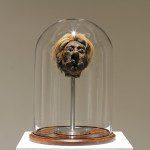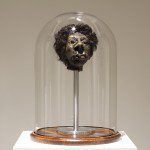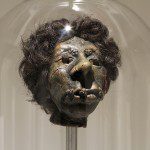Text by Amber Berson
Tsantsas are shrunken heads. While headhunting was common to many parts of the world, head shrinking has only ever been documented by members of Jivaroan tribes of the Amazon rain forest. Despite their incredibly specific origin, tsantsas are often mistakenly associated with wider Latin American, and even African, culture.
Perhaps this is the result of the Western museological tradition that has informed the public collective understanding of global cultures. What’s more, now more than ever, the world is at our fingertips by way of mass media, advertising, the omnipresent Internet – deepening our conflation of cultures. The market for shrunken heads, although withered, has not vanished, and both authentic and counterfeit Tsantsas continue to circulate. While musicological professionals are engaging in the hard work of repatriating the objects, developing relationships with the communities from which the heads were acquired, and debating the ethics of displaying human remains, the public’s taste for Tsantsas has not shifted accordingly.
Renato Garza-Cervera’s Springbreakers Tsantsas series is a reflection of the public search for global meaning. Garza-Cervera, like many Mexicans, spends his holidays on the beach. Mexico’s economy relies heavily on the tourist industry, so the artist often found himself sharing his vacation spot with tourists. While Tsantsas have no relationship to Mexico, Garza-Cervera is able to recreate them, using tourist models, in his home country without any question of authenticity. Springbreakers Tsantsas began six years ago, and while some were created of more obviously stereotypical tourists, on the well tread beaches of Cancun, the Maya Riviera and the Baja California, many were created of the subtler, but equally relevant tourists of the Oaxaca coast and of North-Eastern Mexico. The Tsantsas we find here are formed from the heads of tourists Garza-Cervera encounters and shares beers with. These tourists are implicit in the exchange. They receive an “authentic” experience – a conversation with a local, a shared beer, a chance to be part of an art project – and the artist creates an equally authentic souvenir of their encounter. With each actor in the exchange participating in this process of “othering,” the souvenir becomes imbued with the ambiguity of accepted stereotypes that that are often proliferated through globalization.
The heads themselves – small sculptures representing a conversation, an exchange between two cultures – are not completely faithful to the original tsantsas, however. Believed to capture the energy of the enemy and force the dead spirit into servitude to the conqueror, traditional tsantsas are talismans of a more obvious war. Garza-Cervera’s Springbreakers Tsantsas motivate us to better understand the idea of cultural borders, in albeit a less sparring way. With the notion of dialogue at its core, the Springbreakers Tsantsas series doesn’t shrink stereotypes; it finds a space for them to be displayed and debated in intriguing ways.

















